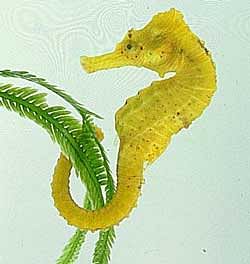NIO breeds endangered yellow seahorses successfully

"Successful life cycle experiment of yellow seahorse will help to facilitate the development of small-scale aquaculture farms by seahorse fishermen, as a viable alternative to capturing wild seahorses and conservation initiatives," scientists at the National Institute of Oceanography (NIO) said.
The experiment which began in late 2008 at NIO's Aqua Nursing Home was successfully closed in February 2010, after the first batch of F2 generation juveniles of seahorses were observed after 382 days of growth.
"The significance of this research in completely closing the life cycle of this endangered seahorse species opens up avenues for commercial aquaculture and conservation initiatives," a senior NIO scientist said.
The researchers say that seahorses are a fascinating and remarkable group of fishes with their unusual body shape and their biology, with males incubating the fertilized eggs in a brood pouch.
The NIO website mentions that at least 25 million seahorses are traded annually for traditional Chinese medicine (TCM), as aquarium fish and curios and nearly 77 countries and territories are involved in the seahorse trade.
"India was contributing to about 30 per cent of global seahorse trade until 2001 and now all species of seahorses have been brought under the schedule I of the Wild Life Act, 1972 to prohibit exploitation," a scientist said.
The oceanic yellow seahorse, Hippocampus kuda (Bleeker, 1852), is widely distributed throughout the tropical Indo-Pacific region inhabiting shallow shore habitats such as mangroves, sea grass beds and estuaries, the NIO website says.
"It is one of the most heavily traded seahorse species in many Southeast Asian countries for TCM and its conservation status is currently listed by the International Union for the Conservation of Nature (IUCN) as 'vulnerable'," it adds.
As per the Convention of International Trade in Endangered Species (CITES), all species of seahorses have been placed under Appendix II which states that captive breeding could be undertaken for stock enhancement programme and aquaculture purposes.
NIO said that several attempts to culture seahorses for successive generations under captivity in the recent past have met with limited success as a result of severe problems of mass mortality and low growth rates due to inadequate nutrition and disease.
Scientists said that improved seahorse husbandry and rearing could help reduce pressure on wild populations, by ensuring that those in captivity live longer and by creating the possibility of trade.